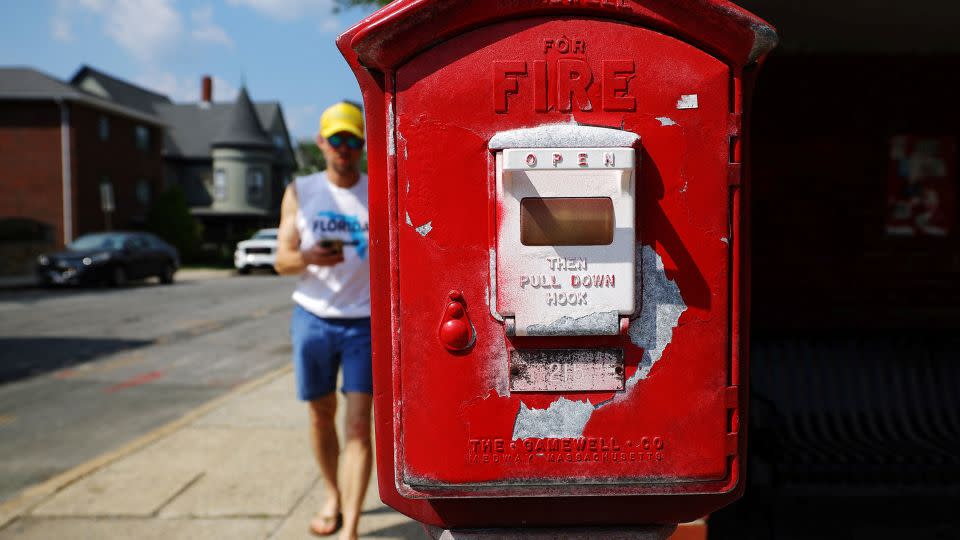When Massachusetts’ 911 system went down, these telegraph alarm boxes became vital again

When the Massachusetts 911 system for emergency calls stopped working on Tuesday afternoon, Boston Police Commissioner Michael Cox noted the city already had a backup solution in place.
Use those little-noticed fire alarm red boxes, he said. They rely on that old yet reliable technology: The telegraph.
“If you’re having any issues, medical-related or EMS or fire-related, you can go and pull your local call box,” Cox said in a news conference. “That’s the red light boxes that the Fire Department has on local streets and corners, to also get medical attention that way.”
The Boston Fire Department offered similar advice in a post on X. “If you have an emergency and need assistance pull your nearest Fire Box,” the department said along with a photo of the device.
Yes, the humble fire alarm box remains an emergency option, available for any passersby to use in Boston and in several other major American cities. Attached to street poles and on the sides of buildings, the boxes – often in faded red paint – use electronic telegraph technology to relay an emergency alert to Fire Department headquarters. Simply open up the protective lid and pull down the hook.
Today, there are still about 1,500 fire alarm boxes around Boston, according to Michael Gerry of the Boston Fire Historical Society.
“Now, most people don’t know what they are,” he told CNN in a phone call. “Nobody uses them anymore because everyone has a cell phone.”
Still, while rarely used, they continue to operate on their own telegraph and power system around the Hub, making for an excellent backup system when power is out or 911 is down.
First in the nation system
The alarm boxes have a notable history in Boston.
Samuel Morse invented the electric telegraph in the 1830s and 40s, allowing users to instantly communicate across long distances, and in the years afterward, Boston residents William Channing and Moses Farmer pushed to use the technology to create a citywide electric fire alarm system.
On April 28, 1852, the apparatus was placed into service, making Boston the first city to use such a municipal system. The first alarm was sent and received the next day at 8:25 p.m. to alert a small fire in a building at the corner of Charleston and Causeway streets, according to the Boston Fire Department.
The system represented a major improvement over the prior systems of ringing bells or yelling for help, and in 2004 it was commemorated with a plaque in downtown Boston near the old city hall.
“Invented by William Channing and Moses Farmer, this system was highly successful in reducing property loss and deaths due to fire and was subsequently adopted throughout the United States and Canada,” the plaque reads.
The alarm boxes were installed at different locations around the city, each with its own unique identifying number, according to the Boston Fire Historical Society. When a person pulls on the hook of a fire alarm box, the box then sends a telegraph to the Fire Alarm Office with its number. So, for example, if someone uses Box 2621, then the office would receive the number 2, then 6, then 2, then 1, and know that there is an emergency near that box’s established location.
The alarm boxes have changed appearance and usefulness over the interceding 172 years. Yet they remain useful, particularly when more sophisticated systems go down, and systems remain active in cities like New York and San Francisco.
“The higher you get in technology, the more susceptible you are to computer code or something else going wrong,” Gerry told CNN. “Whereas the fire alarm boxes are old technology … but are not reliant on high-technology information to work.”
In December 2018, amid another 911 outage, a Boston resident used an alarm box to report a fire on Endicott Street in the North End, according to CNN affiliate WBZ. “I give credit to the resident for knowing to pull that box,” firefighter Marc Sanders told the affiliate.
It was a fortuitous location. That resident used Box 1212 – the same location as the first ever fire alarm in 1852, according to Gerry.
Just last week, firefighters put out a fire at a well-known inn on Cape Cod after a clerk pulled the fire alarm box and called 911, according to The Boston Globe.
Yet there is a reason 911 dispatch centers have largely made the old technology obsolete. The fire alarm boxes only allow one-way communication, and there’s no method to communicate any further messages or information. The Fire Department has no way of knowing what they will find when they arrive, whether it be a fire, a medical emergency, a need for law enforcement – or just a false alarm. Plus, almost everyone nowadays has a cell phone to call 911.
On Tuesday, their return to relevance was short-lived. The 911 system came back online after about two hours, again relegating the fire alarm boxes to secondary importance.
One person actually pulled a fire box during that period, but investigators did not find anything, according to Boston Fire Department public information officer Brian Alkins.
There were no reports of emergencies impacted by the outage, which a preliminary investigation revealed was caused by a computer firewall and not due to a cyberattack or hack. But the exact reason the firewall “stopped calls from reaching dispatch centers remains under review,” the state’s office of public safety and security said in a statement on X on Wednesday.
Massachusetts’ public safety answering system received an average of 8,800 calls per day in 2023, according to the statement.
While many cities have removed the fire alarm boxes, the outage showed why Boston has kept them functioning.
“I guess we always will, because of instances just like (Tuesday),” Gerry said.
For more CNN news and newsletters create an account at CNN.com

